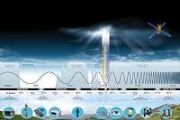
Copernical Team
NASA's STTR Program Funds Innovative Small Business and Research Partnerships
 NASA, in its continuous effort to turn groundbreaking research into tangible technology, has announced a significant boost for small businesses through its Small Business Technology Transfer (STTR) program. This initiative plays a pivotal role in supporting small enterprises and their research partners, particularly during the critical early stages of technological development.
In a recent
NASA, in its continuous effort to turn groundbreaking research into tangible technology, has announced a significant boost for small businesses through its Small Business Technology Transfer (STTR) program. This initiative plays a pivotal role in supporting small enterprises and their research partners, particularly during the critical early stages of technological development.
In a recent NASA's Transition to Commercial Space Networks: A Leap in Wideband Communication
 As NASA's venerable Tracking and Data Relay Satellite (TDRS) constellation nears retirement, a fresh era of space communication is on the horizon. The Space Communications and Navigation (SCaN) program, a cornerstone of NASA's communication strategy, is spearheading efforts to transition NASA missions towards utilizing commercial space-based relay services for their near-Earth communications nee
As NASA's venerable Tracking and Data Relay Satellite (TDRS) constellation nears retirement, a fresh era of space communication is on the horizon. The Space Communications and Navigation (SCaN) program, a cornerstone of NASA's communication strategy, is spearheading efforts to transition NASA missions towards utilizing commercial space-based relay services for their near-Earth communications nee SDA awards contracts for 54 Tranche 2 Tracking Layer satellites in missile defense push
Sasken's Novel Satellite Product Enhances Communication in Disaster Scenarios
 Sasken Technologies Limited (Sasken), a prominent player in system design and integration, has recently announced a significant milestone in satellite communication technology. The company unveiled the world's first LTE-technology-based satellite product, named the Mobile Satellite Equipment (MSE). This novel product is set to revolutionize the field of critical communications, particularly in s
Sasken Technologies Limited (Sasken), a prominent player in system design and integration, has recently announced a significant milestone in satellite communication technology. The company unveiled the world's first LTE-technology-based satellite product, named the Mobile Satellite Equipment (MSE). This novel product is set to revolutionize the field of critical communications, particularly in s Sidus Space launches innovative Multi-Material 3D Printing Division for Space Applications
 Sidus Space, Inc. (NASDAQ: SIDU), recently marked a significant milestone in its growth trajectory by introducing an innovative Multi-Material 3D Printing Division. This new venture signifies a strategic expansion of the Company's capabilities beyond its traditional scope of hardware and satellite manufacturing, delving into the realm of advanced engineering and 3D printing services.
Utili
Sidus Space, Inc. (NASDAQ: SIDU), recently marked a significant milestone in its growth trajectory by introducing an innovative Multi-Material 3D Printing Division. This new venture signifies a strategic expansion of the Company's capabilities beyond its traditional scope of hardware and satellite manufacturing, delving into the realm of advanced engineering and 3D printing services.
Utili Mars Express unveils potential water resource for future Mars missions at equator
 ESA's Mars Express spacecraft has made a significant breakthrough in our understanding of Mars's hydrological history by uncovering extensive layers of water ice at the planet's equator. This finding, derived from new data analysis by the Mars Advanced Radar for Subsurface and Ionosphere Sounding (MARSIS), suggests the presence of ice layers stretching several kilometers below the surface in the
ESA's Mars Express spacecraft has made a significant breakthrough in our understanding of Mars's hydrological history by uncovering extensive layers of water ice at the planet's equator. This finding, derived from new data analysis by the Mars Advanced Radar for Subsurface and Ionosphere Sounding (MARSIS), suggests the presence of ice layers stretching several kilometers below the surface in the To the Moon and back: modern lunar exploration
 Japan, whose unmanned "sniper" probe will attempt a lunar landing on Saturday, is one of many countries and private companies launching new missions to the Moon.
It is a feat so far only achieved by four nations - the United States, the Soviet Union, China and most recently India - with spacecraft often losing communication or crash-landing.
Modern lunar exploration programmes include
Japan, whose unmanned "sniper" probe will attempt a lunar landing on Saturday, is one of many countries and private companies launching new missions to the Moon.
It is a feat so far only achieved by four nations - the United States, the Soviet Union, China and most recently India - with spacecraft often losing communication or crash-landing.
Modern lunar exploration programmes include US spaceship lost over S. Pacific following failed Moon mission
 A crippled American spaceship has been lost over a remote region of the South Pacific, probably burning up in the atmosphere in a fiery end to its failed mission to land on the Moon.
Astrobotic's Peregrine lander was launched on January 8 under an experimental new partnership between NASA and private industry intended to reduce costs for American taxpayers and seed a lunar economy.
But
A crippled American spaceship has been lost over a remote region of the South Pacific, probably burning up in the atmosphere in a fiery end to its failed mission to land on the Moon.
Astrobotic's Peregrine lander was launched on January 8 under an experimental new partnership between NASA and private industry intended to reduce costs for American taxpayers and seed a lunar economy.
But Axiom launches third mission to ISS, carrying European space hopes
 An all-European crew including Turkey's first astronaut launched for the International Space Station on Thursday with Axiom Space, as countries increasingly look to the private sector to fulfill their ambitions in the cosmos.
A SpaceX Crew Dragon fixed to the top of a Falcon 9 rocket blasted off Kennedy Space Center in Florida at 4:49 pm local time (2149 GMT), and should reach its destinatio
An all-European crew including Turkey's first astronaut launched for the International Space Station on Thursday with Axiom Space, as countries increasingly look to the private sector to fulfill their ambitions in the cosmos.
A SpaceX Crew Dragon fixed to the top of a Falcon 9 rocket blasted off Kennedy Space Center in Florida at 4:49 pm local time (2149 GMT), and should reach its destinatio AST SpaceMobile Launches $100 Million Stock Offering Amid Strategic Tech Investments
 AST SpaceMobile, Inc. (NASDAQ: ASTS), a pioneering company in space-based cellular broadband technology, has recently made two significant announcements that mark a substantial leap in its quest to deliver global connectivity. The company has launched a public offering of $100 million of its Class A common stock and secured a strategic investment from industry giants AT&T, Google, and Vodafone.
AST SpaceMobile, Inc. (NASDAQ: ASTS), a pioneering company in space-based cellular broadband technology, has recently made two significant announcements that mark a substantial leap in its quest to deliver global connectivity. The company has launched a public offering of $100 million of its Class A common stock and secured a strategic investment from industry giants AT&T, Google, and Vodafone. 































